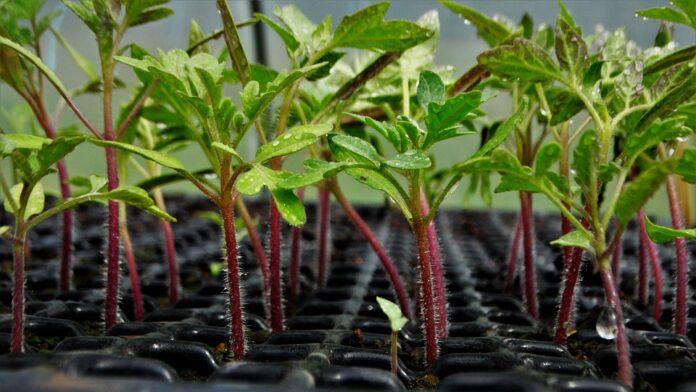According to classical mythology, chimeras were beings that had the heads, bellies, and tails of different animals. By extension, simple organisms that have developed from different individuals are called this way. Well, strange as it may seem, we are surrounded by crops made up of chimera organisms. Currently, a large part of the crop plants (except for monocotyledons such as cereals) are combinations between two different organisms.
This is achieved thanks to the grafting technique, which consists of cutting and gluing two (or more) plants so that they grow as one. In general, one of the parties provides the roots (rootstock, foot or pattern) and another the aerial part (the variety, stem, graft or spike). The use of grafting has millennia of history. In fact, Greek and Roman sources indicate that grafting was already widely practiced in the Mediterranean region in the 5th century BC.
Why are grafts important in plants?
The grafting technique is widely used in the world and is used in the cultivation of many plant species. Vines and most fruit trees (citrus, apple, pear, almond and chestnut trees), as well as numerous horticultural species (pumpkin, courgette, melon, watermelon, eggplant, pepper and tomato) are cultivated as grafted plants in a systematic way.
The benefits of grafting are due to the synergy offered by obtaining a chimera plant that adds the positive attributes of two different plants. On the one hand, the variety provides the desired type of resource, generally a fruit, with optimal properties. On the other hand, the rootstock provides resistance to one or more types of stress, captures more water and nutrients or increases the vigor of the grafted plant.
grapevine and grafted citrus
Vine and citrus are two clear examples of crops closely linked to the grafting technique. In the 19th century, a plague of a hitherto unknown insect from America, phylloxera (Daktulosphaira vitifoliae), devastated the vineyards of Europe, including those of Spain.
After this event, it was found that the use of certain vine rootstocks managed to overcome the plague. Even today, by law in Spain, rootstocks resistant to this insect must be used; without these neither vine nor wine would be produced.
As for citrus, plantations should start from certified specimens, free of viruses and grafted on rootstocks tolerant to the citrus sadness virus. This virus devastated many plantations in the last century causing the sadness disease by which the trees died in just a few weeks.
The grafted tomato
The tomato is one of the most cultivated vegetables worldwide. Their graft is so widespread that only in Spain more than 72 million grafted tomato plants are produced each year.
Grafts are used in tomato to provide resistance to nematodes, fungi and bacteria and increase tolerance to high and low temperatures, soil salinity and drought conditions. In addition, they can increase the vigor of the plant and its yield. A curious case of grafted tomato is the Tomtato®an ingenious idea in which tomato (aerial part) and potato (radical part) are combined, obtaining fruits (tomatoes) and tubers (potatoes) from the same plant.
How to make a graft?
Making a graft can be simple, although it requires some skill and some care. In non-woody horticultural species it is advisable to graft on young plants no more than two hands tall. A cutting instrument (razor, knife, scalpel, cutter…) clean and disinfected (for example, with alcohol) is needed.
The simplest cut consists of sectioning the stem of the rootstock and variety near the basal part, at an angle of 45°. The stem of the variety is joined with the root part of the rootstock and the union is fixed with various instruments: string, paper, plastic, tape, tweezers or special clips for grafting.
Following fixation of the sectioned stem, the grafted plants should be placed in conditions of high relative humidity and low light for at least one week. In the video that follows this paragraph you can see how the tomato grafting process is in a professional nursery.
On the other hand, woody plants are often grafted when growth stops and buds are dormant in the cold season. The types of graft are very varied and normally the joints are surrounded by tapes, ropes, plastics or paraffin, as support and protection elements, especially preventing said area from dehydrating.
In the case of massive grapevine grafting, omega-type grafting is usually used. In the video that follows this paragraph you can see how it is done in a professional nursery.
How do grafted plants survive?
At the time a graft is made, a large wound is exerted on the plant that disconnects the aerial part from the root by breaking the vessels, preventing water and mineral nutrients from reaching the plant. On the other hand, the rootstock, which provides the root, stops receiving the compounds derived from photosynthesis.
After the cut, both the variety and the rootstock are in a critical situation and quickly initiate a sequence of processes, from the organ level to the molecular level, which manage to repair the damage and restore the functionality of the grafted stem as quickly as possible. If the genetic distance between both parts is not too great, the grafting technique has been good and the post-grafting environmental conditions are adequate, the grafting will probably be successful.
Various tissues of the stem participate in the process (the cambium either procambium, among others) that begin to produce new cells to fill the space between the variety and the rootstock, promoting their adhesion. Later, these newly formed cells proliferate and form the body of what is called union callus or graft union.
The chimera plants of the classical world were mythological beings
At a later stage, within the junctional callus, cell groups appear that begin to divide and differentiate to form new vascular tissues. Little by little, the vascular tissues unite, restoring bidirectional transport between the rootstock and the variety, consolidating the union a few days later. Eventually both plants will grow as one.
The chimeras of the classical world were mythological beings. Grafts, however, are chimeras with which we have lived for centuries without realizing their existence and importance. Many new uses and applications are still hidden behind them, as well as scientific discoveries that explain their formation and operation in more detail.
Reference article: https://theconversation.com/plantas-chimera-arte-y-ciencia-de-los-injertos-175853














![[Img #74661]](https://thelatestnews.world/wp-content/uploads/2024/12/The-power-of-ultrasound-300x200.jpg)